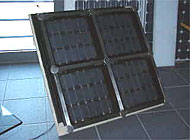Solar cells shine in Ticino

It's no great surprise that Switzerland's only producer of solar cells is tucked away in one of the sunniest corners of the country.
Solterra is located on the Swiss-Italian border in the town of Chiasso, and since it was founded in 1994 it has been developing alternatives to traditional power sources.
Today it manufactures photovoltaic (PV) cells, modules and systems used to siphon the sun’s rays into useable electricity in homes and businesses.
Solar power has become increasingly popular as an environmentally friendly source of energy over the past few years. Governments are encouraging the use of solar panels across Europe through subsidies as they hope to cut down on fossil fuel consumption.
Solar power has other advantages, too, according to Solterra’s marketing director, Lorenzo Cerofolini. One is that it can provide power to out of the way places, which are not connected to the main electricity grid.
“With solar power one can supply power to practically any location,” Cerofolini told swissinfo. “It brings power to places which have traditionally been impossible to reach, and this helps spur economic development.”
Benefit to connected consumers
Solar electricity also works to consumers’ advantage because it can be used to provide energy even in buildings connected to systems powered by the main grid.
“Any excess power produced can be sold back through the grid to the local utility company,” added Cerofolini.
In Switzerland, Grid-connected solar technologies in both residential and commercial buildings are growing at a rate of more than 30 per cent a year.
The Swiss government has so far set aside SFr1.3 million ($770,000) to promote PV plants connected to the electricity grid.
“Solterra has already been consulted on this for a considerable supply. At present our production is 4000 Kilo Watts and will grow consequently,” said Cerofolini.
On average one house consumes 3 Kilo Watts per hour.
Research and development
As well as producing solar cells, Solterra also spends a great deal of time and effort on research and development.
Among the most recent products developed by the company are solar cells that double as insulating roofing tiles – these can be used on any domestic roof.
“We have a close relationship with the Swiss Federal Institute for Technology in Lausanne and some Italian universities,” added Cerofolini.
Mobile phone users, too, can also benefit from solar power with mini-modules capable of recharging cellular phones.
Why Ticino?
Cerofolini told swissinfo with the increased government support for solar power in domestic buildings in both Italy and Germany the company’s Chiasso location was ideal.
“Ticino is certainly an ideal place to be located as it sits close to both the growing Italian PV market and the very popular German PV market,” explained Cerofolini. “Also wages in Ticino are lower than in other Swiss cantons.”
Power output
The Chiasso production plant produces about 1,000 photovoltaic cells per hour. These are then put into PV modules made up of between 36 and 72 cells. They are capable of producing 12 or 24 volts when exposed to daylight.
Cerofolini explained that the cells produced are much more efficient than they used to be. “Based on the size of the cells used to manufacture the modules, various power outputs can be obtained to a maximum of 160 WP – WP is watts per pico a measure of the maximum power produced from a panel,” said Cerofolini.
by Tom O’Brien

In compliance with the JTI standards
More: SWI swissinfo.ch certified by the Journalism Trust Initiative









You can find an overview of ongoing debates with our journalists here . Please join us!
If you want to start a conversation about a topic raised in this article or want to report factual errors, email us at english@swissinfo.ch.